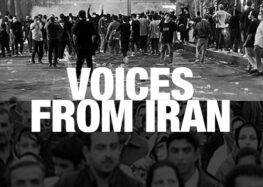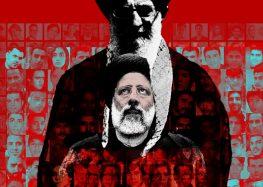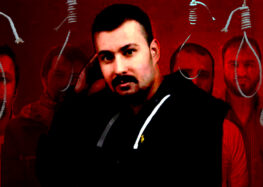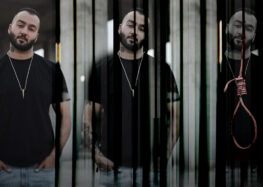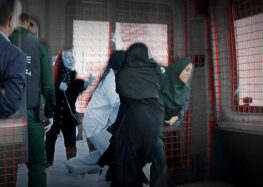“They’re Torturing Me Without Touching Me” Says Unarmed Protester Shot by Iranian Security Forces
 Hero Construction Worker Was Shot While Trying to Get a Woman and Child to Safety
Hero Construction Worker Was Shot While Trying to Get a Woman and Child to Safety
*Read ABC News coverage of Mahyar Ebrahimi’s story here.
Two years after Iran’s massive November 2019 protests, the government has yet to respond to questions about its deadly use of force to suppress the demonstrations, which occurred in more than 200 cities, leaving hundreds dead and thousands injured.
At the time, Mahyar Ebrahimi was 30 and living in the struggling working-class Andisheh township near the city of Karaj, west of the capital Tehran. He tried to stay away from the protests, but “even people with their spouses and children” were joining them, leaving him “tormented,” he told the Center for Human Rights in Iran (CHRI).
He ultimately joined them, too, and while trying to help a woman and her child to safety, was shot in the face.
(Warning, disturbing images of Ebrahimi’s injuries in this link).
Two years later he’s still trying to heal while unable to cover his medical and living costs because no one will hire him. Like many protesters who were severely injured, employers won’t consider Ebrahimi for a job because they fear reprisals by security agents for working with an alleged “saboteur”—as many protesters were labeled by Iran’s current president (and previous judiciary chief) Ebrahim Raisi.
At least 304 people, including at least 23 children, were confirmed killed at those protests, according to Amnesty International. Reuters has reported deaths as high as 1,500.
No Iranian official has been prosecuted for the killings. Instead, they’ve been promoted while the government has given many of the families of murdered protesters and bystanders so-called “blood money” in return for their silence.
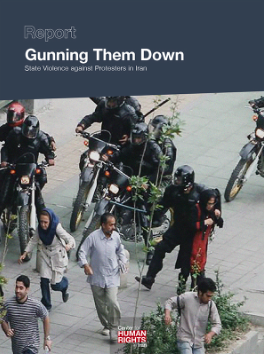 Other family members who have tried to seek justice have been harassed by intelligence agents, threatened with arrest, and blocked from mourning their loved ones.
Other family members who have tried to seek justice have been harassed by intelligence agents, threatened with arrest, and blocked from mourning their loved ones.
Testimonies by injured protesters and killed protesters’ families describe severe violence by the police and security forces, including bullets being shot into crowds. Many of those who survived the shootings are still suffering from their physical and psychological wounds—and struggling to cover medical costs because they’re unable to regain employment or collect disability.
“I was not the first person to be shot,” Ebrahimi told CHRI in a Persian interview that has been translated to English. “There were two other guys who I knew from our local religious group. One of them died and the other was seriously injured.”
From Protester to Hero
On November 16, 2019, the day after a sudden rise in gasoline prices and the first day of public outcry, the streets of Andisheh, like many parts of the country, became scenes of protests that were ultimately violently repressed by police and security forces.
The Andisheh township has six housing units. Phase 1, where Ebrahimi lived, is considered the least developed, with poorly-equipped medical centers and aging urban facilities including public walking areas. This is where most of the protests in the district took place—and quickly turned violent.
Ebrahimi, a single man with a technical diploma who was working in construction at the time, left his home at 10 a.m. on November 16 after receiving an alert about a demonstration that he soon joined. He remembers it being very peaceful; many had even brought their children along.
“Then after a while a bunch of people joined the main crowd from the side streets, moving toward 12th Sq.,” Ebrahimi told CHRI. “They had keffiyeh scarves on their faces. Suddenly the buzz in the crowd got louder and the slogans changed. These individuals were even cursing at people who were watching from their windows and were not doing anything. They were instigating them to come out of their houses.”
According to Ebrahimi, the crowd then moved from 12th Sq. toward a Basij paramilitary base on East Shahed St., one of the busiest corners of the township. As soon as they got there, the situation became chaotic and tense. The anonymous individuals who had covered their faces attacked a sandwich shop next to the Basij base and wrecked it.
Ebrahimi told CHRI that the violence and provocative behavior exhibited by a few individuals, some of whom burned Islamic flags, incited anger and violence among the demonstrators. He insisted, however, that ordinary people were not acting violently; it was only a small number of individuals who committed vandalism.
Around 1 p.m. Ebrahimi and many others dispersed and returned home. He joined them again the next day, on Sunday around 7 p.m., at 8th Sq.
This time the crowd moved toward the Basij base, where Islamic Revolutionary Guard Corps and Basij units carrying special equipment including Kalashnikovs, batons, and tear gas had gathered in one of the dead-end side streets.
“I spoke face to face with the base commander and pleaded with him to send the [heavily-armed] units back inside the base because their presence was causing all the tension,” Ebrahimi told CHRI. “There were a lot of families with children who were on the street that night as well.”
It was too late. A few rocks were thrown by the crowd at the Basij units and one of the units started firing tear gas into the air. A tear gas canister broke the neon sign of a butcher shop and more tear gas shots followed. In three minutes, more than 50 tear gas canisters were shot toward the crowd, said Ebrahimi.
At that point, shots were being fired by the security forces based inside and around the Basij base. People were fleeing, trying to find somewhere to hide. Ebrahimi took cover behind a wall in a nearby street.
“While all this was going on, a lady and her small daughter asked me to take them from West Shahed St. to East Shahed St.,” Ebrahimi said. “The shooting was intense. When I took them there and returned to the same street where I had taken cover, midway I saw another lady and I was about to tell her she shouldn’t be there. Before I finished my sentence, I was shot and fell unconscious.”
Ebrahimi’s descriptions indicate that the protests occurred organically, which sharply contrasts with accusations by state officials that the protests were orchestrated by foreign powers and groups seeking to overthrow the Islamic Republic. Far from being anarchists and saboteurs, the protesters were overwhelmingly peaceful until security forces started attacking them, according to witnesses including Ebrahimi.
Ebrahimi’s case is proof. He was shot while trying to help women and children escape bullets.
From Hero to ICU Patient
Ebrahimi’s family found him by accident—he had been admitted under a false name to protect his security—fighting for his life after being carried to a hospital run by the State Welfare Organization, he told CHRI.
After being revived four times, the doctors there decided he should be transferred to Milad Hospital for treatment. But Ebrahimi’s father did not have enough money for the ambulance service and instead handed over his driver’s license as a security deposit so he could pay later. After eight days in the intensive care (ICU) unit of the Milad Hospital, Mahyar’s condition slightly improved and he was moved to a public ward.
Yet his family could not afford any more hospital expenses, so he asked to be discharged despite being warned of the serious long-term health consequences of leaving before he had recovered. When he went on hunger strike in protest over being kept in the hospital, Ebrahimi was finally allowed to go home after four days.
Two years later, he has severe injuries in his jaw, teeth, one eye and ear, as well as his facial nervous system. His discharge papers from Milad Hospital repeatedly mention the fact that his injuries were caused by a bullet, without further explanation.
“When the specialist doctors at Fatemeh Zahra Hospital heard that I was shot by a bullet, they made excuses and referred me to other doctors,” said Ebrahimi, implying that the doctors feared being punished for treating a protester. Because it took longer to receive treatment, his injured eye got worse.
The loss of hearing in his right ear, the worsening of the injuries in his right eye and eyelid, losing half the nerves in his face, and worsening jaw and teeth injuries are all the result of incomplete treatments for a bullet wound caused by a Basij militia member who has never been punished for shooting an unarmed protester. No one even looked for the perpetrator.
Iranian authorities claim they’ve financially compensated the families of victims of the November 2019 protests. However, no state agency has offered Ebrahimi help, despite being aware of his condition. He was undoubtedly marked as a security threat by intelligence agents when he was being transferred from hospital to hospital to get treatment for his bullet wound.
“They’re torturing me without touching me,” Ebrahimi told CHRI.
Injured by the State and Then Blocked from Finding Work
Almost two years after being shot by a militia member who was never prosecuted, Ebrahimi is still suffering from excruciating pain while living under severe pressure from unpaid treatment costs.
Many friends and relatives are avoiding him while his family is facing a mountain of debt that he cannot help repay because he has been deemed unemployable.
“During this time, I have been looking for work but as soon as they see my medical records and hear about how I was shot, they reject me and say there’s no work available,” Ebrahimi told CHRI.
Nor does Ebrahimi have hope for justice.
During the past two years I didn’t file any complaints with the judiciary because I was afraid of this regime,” he said. “I was afraid that they would threaten my life and my family or hurt them and throw them in jail.”
“I am a human being and I have the right to live,” he said.
Read this article in Persian (warning: disturbing images)

